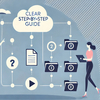
We recently posted an article on using parallelism in technical writing and this was kind of thought-provoking. Parallel structure is one of the most commonly used literary devices and while its role is a bit different in literature and help authoring, it proves to be useful in both fields. So, in this article, we are going to analyze more devices pertaining to literature to understand what can be used by technical writers to improve the quality of their content.
It may seem that these two spheres are too far away from their overlapping to be meaningful. We will see about that in a minute.
First, it is necessary to mention that writing books and user manuals is done using the same primary tool – the language. The purpose of these acts is not the same, hence the differences in approaches. Which does not mean there are no common techniques although that can help achieve different goals.
Metaphor/Simile

Metaphors are very common in literature and so are similes which are a type of metaphor. We won’t go deep into explaining the difference between them, just remember that when some action, character, idea is described through something else, compared with something, and it has only some shared characteristics while everything else is not common – this is a metaphor. In similes, words “like” or “as” are used for comparison.
‘The world’s a stage.’ This is a metaphor. Quite often understanding them requires deep thinking.
You can guess that’s the opposite of what is usually needed from a technical text. Words should be clear and leave no place for doubt.
However, we believe there’s a place for metaphors in technical docs as well! Sometimes a notion can be so complex that using a metaphor can help readers grasp the concept faster.
This device is used a lot in popular science. As for user manuals, depending on your target audience, using metaphors to simplify things can be great! Novice users will definitely appreciate overcomplicated stuff explained through down-to-earth concepts.
Euphemism
We use a lot of euphemisms even without noticing it. Human psyche works this way: it comes up with new ways of describing things it finds inappropriate, scary or having any other ‘bad’ label.
Euphemisms are widely used in both literature and technical writing. Weren’t we supposed to be as blunt as possible in technical documents? Well, no, not always.
For example, when you are talking about errors in an app and name them directly, sure, you should use the proper term for it – ‘an error’, but when the text is a bit more general, you’d rather use something less unpleasant. ‘An issue’ is a good word to use.
When you are talking to your readers through technical documentation you are basically talking to clients and, so, some of the best practices of using euphemisms still apply. As long as they do not interfere with understanding the text.
Irony

Having a sense of humor is a virtue, but not everyone has it. This is why using irony in technical writing is like playing with fire.
We love ironic books, but we are kind of ‘ready’ to face irony there. When people read user manuals they are often having some issues with the product, fail to figure out how stuff works on their own; they are frustrated. Not every person likes to listen to irony at that particular moment. It can look more like mocking.
Nevertheless, some companies are trying to create friendlier conversations with their clients using a humorous tone. The choice is yours but we would not recommend this unless you have an army of lawyers by your side 🙂
Conclusion
Today we’ve covered three literary tools quite common for user manuals. But there are lots of literary devices that you will never see in a technical doc: allusion, alliteration, foreshadowing, flashbacks…
Are there any other literary devices you use in your help topics? Do you spice your tech writing up? 🙂
Feel free to share your examples in the comment section below!
Good luck with your technical writing!
ClickHelp Team
Author, host and deliver documentation across platforms and devices



